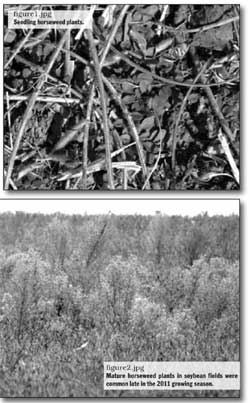Considerations With (Very) Early-Season Weed Management
URBANA, ILL.
The mild winter and current above-normal air temperatures might impact weed management in 2012, according to Aaron Hager, associate professor of weed science at the University of Illinois.
The mild winter has resulted in an abundance of winter annual weed vegetation growing in fields across the state. “Survivorship over the winter months of weeds that emerged last fall was undoubtedly higher than usual, and the recent stretch of warm air temperatures has prompted these weeds to resume growth several weeks ahead of schedule,” said Hager.
There are many good reasons to start taking action against these weeds. “The higher-than-normal air temperatures and abundant sunshine we currently are experiencing promote good activity of burndown herbicides,” Hager explained. “Soil conditions across much of the state are conducive for pre-plant tillage operations that can effectively control winter annual weeds.”
Ideally, weed management plans should control existing vegetation before viable seeds are produced. Under current conditions, seed production is likely to occur sooner than normal. Early elimination of winter annual weeds also reduces the oviposition sites of insects such as the black cutworm.

One species of particular concern this spring is horseweed (a.k.a. marestail). Like other annual plant species, it completes its life cycle in one year. Unlike many other annual species, however, horseweed can exist as a winter or summer annual.
Populations of winter annual horseweed typically emerge in the fall, a few days or weeks after seed is dispersed from the parent plant (Figure 1). Summer annual populations emerge in spring or perhaps as late as early summer. In northern Illinois, most horseweed has a winter annual life cycle. Spring emergence in Illinois is more common south of Interstate 70. Plants with both winter and summer annual life cycles can be found across central Illinois.
“Glyphosate-resistant populations of horseweed are common in southern Illinois, and we are concerned that glyphosate-resistant populations are becoming increasingly common across central Illinois,” said Hager. Anecdotal observations during the late summer months of 2011 revealed that horseweed was present in many central Illinois soybean fields (Figure 2).
“Although we did not screen any of these horseweed populations for resistance to glyphosate, we still encourage weed management practitioners across central Illinois to be aware that glyphosate resistance does occur in Illinois horseweed populations,” Hager said. Burndown of glyphosate-resistant horseweed requires alternative herbicides or tank-mixing other herbicides with glyphosate.
“If you suspect that you have glyphosate-resistant horseweed, you might consider adjusting your burndown herbicide program before an application is made to increase the likelihood of achieving complete control before planting,” said Hager. “Regardless of whether or not a horseweed population is resistant to glyphosate, it is advisable to control horseweed before plants exceed four to six inches in height.”
Soil conditions currently are conducive for pre-plant tillage operations, and many farmers are taking advantage of these unseasonable conditions to prepare fields for planting. Tillage, coupled with the increasing soil temperatures, can promote seed germination of summer annual weed species.
“If tillage is done in mid-March without applying soil-residual herbicides within a few days of the last tillage operation, be sure to scout for emergence of summer annual weed species prior to planting,” said Hager. “If summer annual species have emerged before corn is planted, consider including a herbicide that has burndown activity when applying a soil-residual herbicide.”
Reduced rates of soil-residual herbicides applied in mid-March are less likely to provide much residual control of summer annual weed species after crop emergence. “If a soil-residual herbicide is applied this early to fields where corn will be planted, consider applying the full recommended rate for the particular soil type,” Hager advised.
Another way to increase the duration of residual weed control following planting is to split the application of the soil-residual herbicide, applying perhaps 50 to 60 percent now or sometime before planting and applying the remainder before summer annual weed species emerge. It is best to control winter annual weeds in fields to be planted to soybean as soon as possible, but extended residual control of summer annual weeds is more likely when soil-residual herbicides are applied closer to planting. Δ